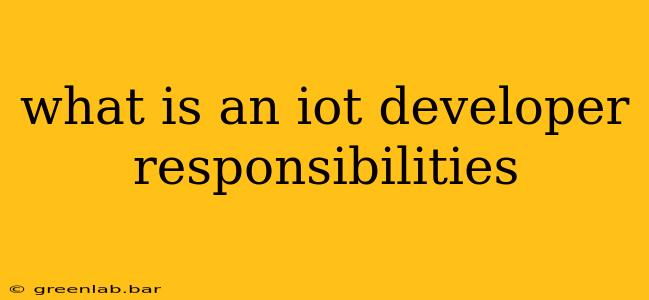The Internet of Things (IoT) is rapidly transforming how we live and work, and IoT developers are at the heart of this revolution. Their role is multifaceted, demanding a unique blend of software engineering, hardware understanding, and problem-solving skills. But what exactly are the responsibilities of an IoT developer? Let's delve into the core duties and required expertise.
Core Responsibilities of an IoT Developer
An IoT developer's responsibilities can vary depending on the company and project, but several core tasks remain consistent across the field:
1. Designing and Developing IoT Applications
This is the cornerstone of the role. IoT developers are responsible for the entire lifecycle of an IoT application, from conceptualization and design to deployment and maintenance. This includes:
- Choosing the right hardware: Selecting appropriate sensors, microcontrollers, and communication protocols based on project requirements and constraints.
- Developing embedded software: Writing code for microcontrollers and other embedded systems to collect, process, and transmit data. This often involves working with low-level programming languages like C or C++.
- Building cloud-based applications: Creating backend infrastructure to handle data storage, processing, and analysis. This might involve working with cloud platforms like AWS, Azure, or Google Cloud.
- Developing mobile and web applications: Designing user interfaces (UI) and user experiences (UX) for interacting with IoT devices. This often involves working with frameworks like React, Angular, or Flutter.
- Implementing security measures: Protecting IoT devices and data from unauthorized access and cyber threats is critical. Developers must incorporate robust security protocols throughout the entire system.
2. Data Management and Analysis
IoT devices generate massive amounts of data. An IoT developer plays a crucial role in:
- Data acquisition: Efficiently collecting data from various sources, ensuring data integrity and reliability.
- Data storage and processing: Designing and implementing systems for storing and processing large datasets, often using databases like MongoDB, Cassandra, or time-series databases.
- Data analysis and visualization: Extracting meaningful insights from data to improve system performance, optimize resource utilization, and identify trends. This frequently involves using tools and techniques from data science and machine learning.
3. Testing and Deployment
Before launching any IoT application, rigorous testing is essential. IoT developers are responsible for:
- Unit testing: Testing individual components of the application.
- Integration testing: Testing the interaction between different components.
- System testing: Testing the entire system as a whole.
- Deployment: Deploying the application to the target environment, including setting up and configuring hardware and software.
4. Maintenance and Support
Once an IoT application is deployed, ongoing maintenance and support are vital. This includes:
- Monitoring system performance: Tracking key metrics to identify and resolve issues promptly.
- Troubleshooting: Diagnosing and resolving problems that arise in the system.
- Providing technical support: Assisting users with any questions or problems they may encounter.
- Software updates and patching: Regularly updating the software to fix bugs, improve performance, and add new features.
Required Skills for an IoT Developer
Beyond the core responsibilities, certain key skills are essential for success in this field:
- Programming languages: C, C++, Java, Python, JavaScript
- Cloud platforms: AWS, Azure, Google Cloud
- Databases: SQL, NoSQL (e.g., MongoDB, Cassandra)
- Networking protocols: TCP/IP, MQTT, CoAP
- Embedded systems: Microcontrollers, sensors, actuators
- Security protocols: TLS/SSL, OAuth 2.0
- Data analytics and visualization: Experience with tools like Tableau or Power BI is beneficial.
- Problem-solving and debugging skills: Essential for identifying and resolving issues in complex systems.
Becoming a successful IoT developer requires a blend of technical expertise, problem-solving abilities, and a passion for innovation. The field is constantly evolving, so continuous learning and adaptation are vital to staying at the forefront of this exciting technology.

